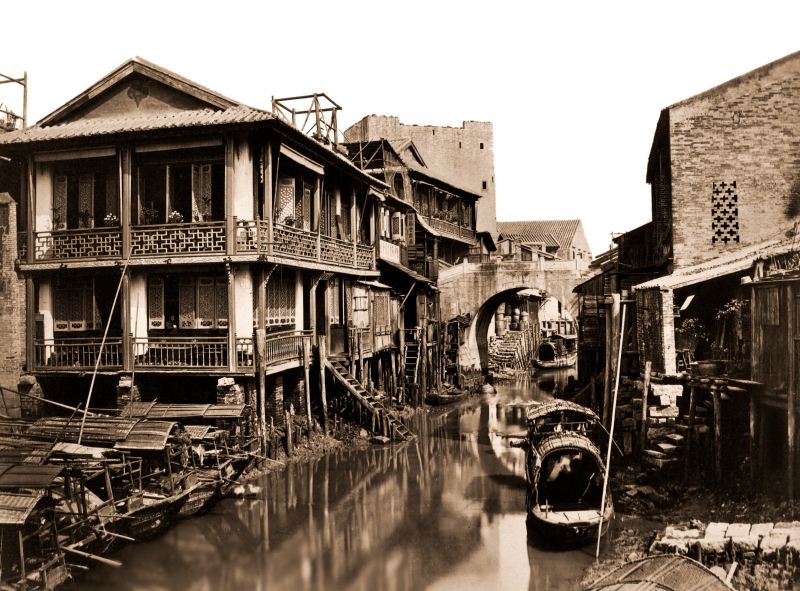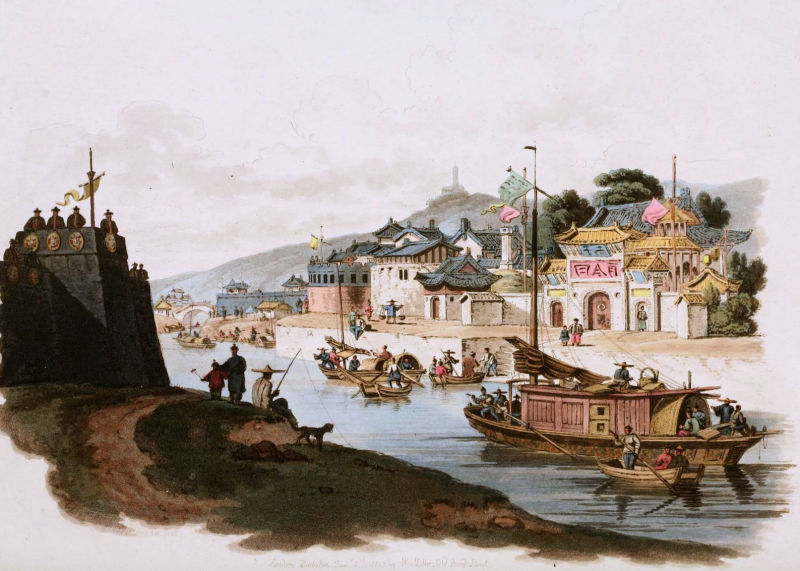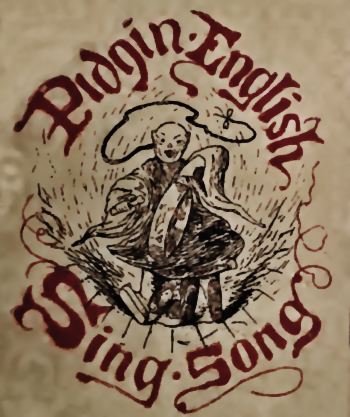Pidgin English in China
Where do the terms ‘no can do’, ‘no pain, no gain’ and ‘long time no see’ come from? Well they all come from China via that strange linguistic curiosity - Chinese Pidgin English. Pidgin has acquired a condescending connotation that suggests it was a simplified language invented by the British for foreign barbarians to use. This is just one of a host of misconceptions about ‘Pidgin English’ which deserve straightening out.

Origin of the name ‘Pidgin’
It is widely held that the origin of the word ‘pidgin’ comes from the Chinese attempt to pronounce the word ‘business’ (this is the official OED etymology). However there is no solid evidence for this origin, but as Chinese Pidgin was used for business it is easy to see why this idea took hold. The sound of ‘pid-gin’ is phonologically very different from ‘biz-niss’, moreover there are several Cantonese sounds that would much more closely match it. The pidgin word for pigeon is actually ‘pidgin’ - so the different sound of ‘business’ must have been blatantly obvious. A much more likely source has been suggested by Kleinecke (1959) who thinks it comes from traders who had had dealings with the South American Indians before the China trade opened up; there the Indians used a word ‘pidian’ to mean ‘people’; from this it could have become the general term for native people wishing to trade. Another possibility is a corruption of the Portuguese ocupação ‘occupation’. The way that ‘business’ became ‘pidgin’ is usually explained in the following way: sometimes ‘ess’ is dropped from words perhaps thinking it is the plural form; then ‘b’ and ‘p’s are closer in sound to Chinese ears - hence Beijing/Peking. So we have ‘pusin’ it is then claimed that ‘dg’ was the best match for ‘s’ hence ‘pidgin’. I find this ‘business’ to ‘pidgin’ transformation rather far-fetched. Another, more logical theory is that 皮钦 pí qīn that can mean ‘business’ was pronounced ‘bizin’ in a local language. However it arose, ‘pidgin’ became the word to mean ‘business’ even if it did not have a similar sound.
Other pidgins
There are many pidgin languages still spoken today but it was the Chinese pidgin that was the first to develop. A pidgin is defined as a language used between peoples who have no shared language, it is not the day-to-day language of either party, if that was the case it would be called a creole. In fact some pidgin languages have over time become so widely spoken that they became creoles. Pidgins are still widely used in western and central Africa where there are many mutually incomprehensible African tribal languages in use. A BBC Pidgin English ➚ digital language service for western and central Africa was launched in 2017.
Portuguese pidgin
Back though to pidgin’s origins in China. When the first European traders arrived on Chinese shores there was no shared language that could be used for communication; they must have resorted to simple gestures. What was needed was a language that was simple to learn and understandable to both sides and that was geared to trading. Many of the sailors, porters and tradesmen (Chinese and European) would have been illiterate and it was important that the language was easy to pick up so both nationalities could use it.
From 1517 to 1684 Portugal was the main trading nation and so the first pidgin language was based around Portuguese not English words. For the first British traders communication was from English to Portuguese to broken Chinese and back again - not a convenient arrangement which must have led to many misunderstandings. From this early stage new words entered the English language: ‘manderyn (mandarin)’ for the officials from Portuguese ‘mandar’ to command; ‘junk’ the traditional boat; ‘pagode (pagoda)’; ‘casse (cash)’ Chinese coins; ‘bamboo’; ‘catty’; ‘chop’ the seal mark, ‘rattan’, ‘tea’ and ‘typhoon’. About the only word of clear Cantonese origin in everyday use from the time of Captain John Weddell’s pioneering visit in 1637 is the fruit ‘Leicheea (lychee)’. Other word imports from this time come from disparate languages including Malay, Portuguese and Cantonese: albino, amok, betel, cashew, cobra, dodo, linguist, mango, marmalade, molasses, mosquito, pagoda, palaver, piccaninny, tank, tapioca and yam. From the China trade came ‘comprador’ (merchant) as well as ‘joss’ (god) from Chinese transliteration of Deus.

First English contacts
The first official British contact was a complete failure. John Weddell was authorized by King Charles I to start up trade with China. Captain Weddell sailed to China in 1637 and upset both the Portuguese and Chinese by his arrogant and aggressive actions - his mission was probably to kick out the Portuguese and force, down the barrel of the gun, the Chinese to trade solely with Britain. The trip is recorded in Peter Mundy’s book ‘The travels of Peter Mundy in Europe and Asia’. Mundy was an accomplished linguistic in French, Spanish and Portuguese; he saw a number of Chinese customs and partook of new foods and drinks including, of course, tea (cha) which was at that time unknown in Europe: “Chaa, what it is: The people there gave us a certaine Drinke called Chaa, which is only water with a kind of herbe boyled in itt. It must bee Drancke warmed and is accompted wholesome.” [Note this is one of the earliest documents in colloquial English, the King James edition of the Bible in English had only just been printed, hence the strange spellings.]
The Chinese impression of this first contact was that they had been visited by a particularly arrogant set of sea pirates (they recorded ‘of all the barbarian intruders, the English are the most violent and dangerous’). The Europeans were termed the 红毛番 hóng máo fān ‘red-haired barbarians’ or 鬼佬 guǐ lǎo or gweilo ‘foreign devils’.
After the unsuccessful and damaging escapade of John Weddell the British made no further formal attempts at direct Chinese trade for over a hundred years. Only after the British East India Company was well established and had started to trade in spices with the East Indies did the British start again seriously looking to China for trade. The East India Company (EIC) set up shop at Guangzhou (Canton) and the ‘pidgin’ language evolved, Portuguese words were replaced by English ones as business began to be dominated by English and American traders.

Canton system
James Flint grew up in China and was one of the first Englishmen to learn mandarin Chinese, it was his actions that precipitated the widespread use of pidgin in China. He was employed by the EIC as their first interpreter and came to Guangzhou in 1741. From his knowledge of Chinese another word entered the English language – processed bean curd ‘tofu’ was first mentioned in Flint’s correspondence with Benjamin Franklin. He put his linguistic skills to good use in trading negotiations but in 1759 he took a complaint about apparent fraud over the heads of the officials at Guangzhou direct to the emperor in Beijing. This infuriated the Chinese. On 24 December 1759 the Qing Imperial court issued an edict: ‘Vigilance Towards Foreign Barbarian Regulations’ (防范外夷规条 Fáng fàn wài yí guī tiáo) that ordered all trade with foreigners to be limited to Guangzhou (the ‘Canton System’ ) during only a short trading season and no Chinese language must be taught to the foreigners – under pain of death. James Flint was punished with imprisonment at Macau for three years. These new regulations forced the use of some sort of intermediary language as only very few Chinese were willing to break the Imperial decree; in any case Europeans thought the Chinese language fiendishly hard to learn and most did not even try.

Pidgin’s heyday
From about 1720 up until the end of the Opium Wars (1860) Chinese Pidgin English became the dominant language for the Chinese trade for all the nations; in fact it became so widespread that it was sometimes used between Chinese people who spoke in a mutually incomprehensible Chinese language for example: mandarin, wu, yue (Cantonese), min, xiang and so on. [Note: the name Chinese Coast Pidgin (CCP) is also used for the language as well as Chinese Pidgin English (CPE), I have chosen to stick with the latter.]
The Earl of Macartney embassy of 1793 which sought to loosen the rules of the Canton system used Chinese not CPE in their unsuccessful dealings. Anderson, who was Macartney's manservant, recorded the use of ‘chinchin’, ‘chop-chop’, ‘chow-chow’ (food) and ‘lobb’ (love) as CPE words.
One of the other main misconceptions about CPE is that it is a ‘simplified’ form of English invented by the British so that the ‘heathen’ and ‘simple’ Chinese could understand it. Actually it is in structure Chinese, with the closest sounding Cantonese words used to imitate the sounds of English words. Chinese word order and grammar are maintained. In those days it was English speaking traders who were much keener to communicate with the local people than the other way around, so the impetus was for the traders to persuade Chinese merchants and workers to adopt and expand it. The Chinese foundations are clearly seen in the appearance of measure words for most nouns, instead of ‘four books’ it is ‘four piecee book’ – ‘piecee (piece)’ is a general measure word like the mandarin 个 gè. CPE has no verb declension or plurals – making it much simpler to learn as well as sticking with its Chinese roots. English have sounds that are not used in Chinese, and so here an approximation to something similar had to be made. Chinese words do not tend to end on consonants and that is why in CPE many words have ‘ee’ or ‘o’ appended for example: belong-ee (belong); much-ee (much); catch-ee (catch) and chilo (child). There is of course the well known difference in the ‘r’ sound between English and Chinese so that Chinese hear and say it as an ‘l’, (English people have just as much trouble trying to accurately make the Chinese ‘r’-like sound.) Some sounds have no close equivalent, for example brother (elder) was expressed as ‘pat-lut-ta’.
As an example look at ‘How much is this?’ which becomes ‘How much-ee dollar?’ in CPE (Spanish dollars were the preferred currency for trade), transliterating the sounds into Cantonese gives ‘hau2 mat1 zi6 daa2 laa3’ (Cantonese has nine tones often put as numbers) written as 口乜治打鏬. In mandarin this would be spoken as kǒu miē zhì dǎ xià which is not really helpful – CPE was geared to Cantonese. Sometimes the Cantonese version sounds rather like English already and then the phrase can be transliterated as a ‘calque’, the clearest example is ‘no can do’ which is probably a direct transliteration of Cantonese ‘m4 dak1 zou6’ 唔得做. Another calque is the very useful word for trading ‘sell’ which by chance sounds the same as the Cantonese ‘se1 lam4’ 些林 which became ‘sellum’ in CPE. Phrases like ‘tomorrow my no can come’ for ‘I can not come tomorrow’ show how ‘my’ was usually used in place of ‘I, me and my’ as well as the Chinese habit of putting the time phrase first.
The most influential document in CPE was produced not by English speakers but by Cantonese Chinese merchants. A small phrasebook entitled the 红毛通用番话 hóng máo tōng yòng fān huà ‘The language of the red haired foreigners’ (1835-50) was printed. An early edition used ‘devils’ instead of ‘foreigners’ which caused some upset and so that was changed. There are only 400 words and phrases arranged by topic - it was not a full dictionary. Entries had the closest Chinese characters to give the approximate pronunciation in Cantonese and also as written characters. Some of the entries show a Swedish origin including duck, pipe and ham (ham in CPE is ‘sin gaa’ from Swedish ‘sinka’).

In 1862 the six volume work by the great Chinese linguist Tong King-sing (1832 – 1892) 唐景星 ‘The Chinese Instructor’ documented a much more complex ‘Chinese English’. This work is really a full English-Chinese and Chinese-English dictionary and not much to do with pidgin. By this time sufficient skilled translators had become available to speak and write directly in each other’s language. In the treaties signed at the end of the Opium Wars the restrictions on trade and teaching of Chinese were removed. As the center of British-Chinese trade moved to Shanghai the pidgin evolved to use some of the local ‘wu’ language words replacing Cantonese but the need for the language was in decline and a version of CPE for mandarin speakers never developed. Never-the-less CPE continued as the language of trade for a long time, only slowly declining in usage. It was only in around 1960 that CPE disappeared from its last stronghold of Hong Kong. Access to mission schools teaching ‘proper’ English and on the other side some traders learning ‘proper’ Chinese removed the need for this strange intermediary language.
Victorian attitudes

Our rather derogatory attitude to this useful language is mainly down to Charles Godfrey Leland (1824 –1903) who was an American slang lexicographer and popular writer. He studied CPE but wrote rather racist toned ‘humorous’ parodies of Chinese people in CPE including the popular ‘Pidgin-English Sing-Song’ (1876). He never visited China but corresponded widely with linguists including Professor Herbert Giles; his actual knowledge of CPE is therefore highly suspect. Here is his transliteration of Little Jack Horner into CPE he transforms most ‘r’s into ‘l’s.
Littee Jack Horner
Makee sit inside corner,
Chow-chow he Clismas pie;
He put inside t’um,
Hab catchee one plum,
“Hai yah! what one good chilo my!” [chilo = child]

Leland does not allude to the fact that European traders were also speaking CPE - it was the language devised for foreign trade between people after all. While the Chinese may have struggled to make English word sounds the English must have struggled with the grammar and so CPE seems a reasonable compromise.
Pidgin was a practical language with just enough words and structure for trade to be unambiguously transacted. Its brief usage in China still managed to have a long term influence; phrases in use today probably originating in CPE include: ‘to make do’; ‘long time no see’; ‘no sabee’ (don’t understand from Portuguese ‘saber’); ‘how come?’; ‘look see’; ‘no can do’ ; ‘where to?’; ‘no-go’; ‘chop-chop’ (hasten); ‘chow’ (food); ‘no pain, no gain’ and ‘chicken fried rice’.
Both Chinese and English are not too fussed about adding new words from other countries. Mandarin Chinese now has hundreds of words which are transliterations of English. Everything from bacon (péigēn 培根) to whisky (wēi shì jì 威士忌 ).